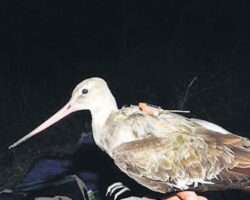A BNHS-tagged bird returns to city’s warmer climes after five months in Siberia

The Bombay Natural History Society (BNHS) tracked a Black-tailed Godwit migrating bird that had been GPS-tagged in Mumbai in March in the chilly regions of South-Western Siberia.
The Bombay Natural History Society (BNHS) tracked a Black-tailed Godwit migratory bird that was GPS-tagged in Mumbai in March to the frigid regions of South-Western Siberia in June. After a winter break, the winged visitor is already returned at the Bhandup pumping station. The bird departed the city in April, and five months later, on a five-day flight, it came back. This demonstrates the birds’ site fidelity, or habit of returning to the same location. The name “Bala” was given to the bird in honour of scientist Dr. D. Balachandran.
According to BN Kumar, head of NatConnect Foundation, “Migratory birds are unofficial brand ambassadors of the ecosystem and they carry the message of prevalent biodiversity in the regions they land.” Therefore, it’s critical to protect their intended destinations, namely the wetlands in the Mumbai Metropolitan Region, said Kumar, a campaigner for the preservation of Navi Mumbai’s wetlands.
The BNHS is currently researching the entire Bala flight pattern and will to release a comprehensive study soon, according to the organization’s deputy director, Dr. Rahul Khot. Senior scientist Dr. Balachandran has spent more than 40 years studying in places like Bharatpur, Rajasthan, and Chilka, Odisha.
Between January and April 2022, BNHS implanted six GPS/GSM tags on three greater and three lesser flamingos to better understand flamingo migration. Gujarat is now home to three flamingos.
Since 2017, BNHS has been doing ongoing ecological monitoring of migrating birds that stop by Thane Creek. The researchers placed bird rings and colour flags at various locations near Thane Creek in order to better understand the habitat utilisation and movement patterns of wintering birds. Around 21,000 birds have been ringed and tagged so far, and the BNHS has been able to obtain reports from both inside and outside of India.
migrating bird tracking
On April 19, 2022, at Navi Mumbai, a Lesser Flamingo (Phoenicopterus minor) named “Humayun” was fitted with a GSM tag and the leg band “ALD.” On June 30, 2022, he returned to Bhavnagar, Gujarat. The Humayun Addulali Bird, named for ornithologist and a pillar of BNHS, is found in wetlands along Nawa Bandar Road, which connects to Bhavnagar Port.
Since 2017, BNHS has been doing ongoing ecological monitoring of migrating birds that stop by Thane Creek. The researchers placed bird rings and colour flags at various locations near Thane Creek in order to better understand the habitat utilisation and movement patterns of wintering birds. Around 21,000 birds have been ringed and tagged so far, and the BNHS has been able to obtain reports from both inside and outside of India.
Migrating bird tracking
On April 19, 2022, at Navi Mumbai, a Lesser Flamingo (Phoenicopterus minor) named “Humayun” was fitted with a GSM tag and the leg band “ALD.” On June 30, 2022, he returned to Bhavnagar, Gujarat. The Humayun Addulali Bird, named for ornithologist and a pillar of BNHS, is found in wetlands along Nawa Bandar Road, which connects to Bhavnagar Port.
‘Salim’ (’ASR’ leg band), named after veteran ornithologist Dr Salim Ali, has reached wetlands near Ghogha town in Bhavnagar district of Gujarat. It took a non-stop flight from the wetland near Vashi on July 6 2022 at 4.57 PM, flew over Dahanu and reached Ghogha Beach on July 7, 2022 at 9.25am. It took 16.28 hrs to cover the 300km journey.
‘McCann’, a juvenile greater flamingo named after Charles MaCann (1899-1980), former assistant curator of BNHS, a naturalist and writer, left the shores of Mumbai on July 14 evening and landed near Ghogha in Gujarat in the morning of July 15 2022. It took 15.45 hrs to cover the 300 km journey. It is the third GPS/GSM-tagged bird reaching Gujrat from Mumbai.
‘Lester’, a subadult greater flamingo named after naturalist and ornithologist Captain C.D. Lester left the shores of Mumbai on 21 July evening and landed in LRK in Gujarat on the night of 22 July 2022. It took 25 hrs to cover ~500 km. Its flight path is similar to ‘Humayun.’
Lester started its journey from Bhandup Pumping Station on July 21 2022 at 21.29; it reached Narbad in Gujarat on 22 July 2022 at 06.30. It took an 11.33 hours stopover near Narbad before flying to Indian Wild Ass Sanctuary at Little Rann of Kutch. Currently, the bird is located near Zinzuwada town. It is the fourth GPS/GSM-tagged bird reaching Gujrat from Mumbai.
‘Khengarji III’ an adult greater flamingo named after Khengarji III of Kutch left the shores of Mumbai on August 2 night and landed in LRK in Gujarat on the evening of August 2, 2022. It took 22 hours to cover 500 km. It is the fifth GPS/GSM-tagged bird reaching Gujarat from Mumbai, and the second to reach LRK.
“Navi Mumbai is the sixth juvenile Lesser Flamingo has shown the local movement in Thane Creek but the data so far received is inconclusive. “We feel it has reached the breeding ground and we will get the full picture once it returns to Thane Creek in the coming months,” Dr Khot said.
